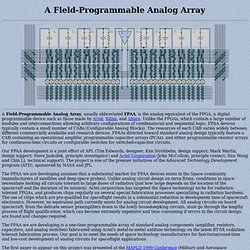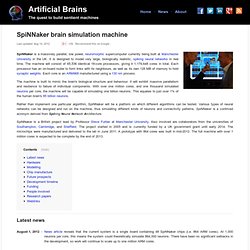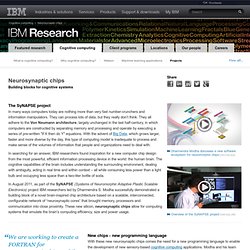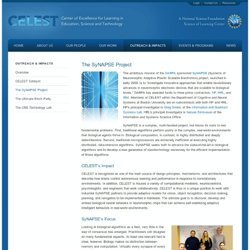

Tim Edwards. Field-Programmable Analog Array. A Field-Programmable Analog Array, usually abbreviated FPAA, is the analog equivalent of the FPGA, a digital programmable device such as those made by Actel, Xilinx, and Altera.

Unlike the FPGAs, which contain a large number of modules and interconnections allowing arbitrary configurations of combinatorial and sequential logic, FPAA devices typically contain a small number of CABs (Configurable Analog Blocks). The resources of each CAB varies widely between different commercially available and research devices. FPAAs directed toward standard analog design typically feature a CAB containing an operational amplifer, programmable capacitor arrays (PCAs), and either programmable resistor arrays for continuous-time circuits or configurable switches for switched-capacitor circuits. The FPAA we are developing assumes that a substantial market for FPAA devices exists in the Space community (manufacturers of satellites and deep space probes).
Current status of the FPAA Future status of the FPAA. Computational Learning and Motor Control. SpiNNaker brain simulation machine. Last updated: Aug 14, 2012 SpiNNaker is a massively parallel, low power, neuromorphic supercomputer currently being built at Manchester University in the UK.

It is designed to model very large, biologically realistic, spiking neural networks in real time. The machine will consist of 65,536 identical 18-core processors, giving it 1,179,648 cores in total. Each processor has an on-board router to form links with its neighbours, as well as its own 128 MB of memory to hold synaptic weights. Each core is an ARM968 manufactured using a 130 nm process. The machine is built to mimic the brain's biological structure and behaviour. Rather than implement one particular algorithm, SpiNNaker will be a platform on which different algorithms can be tested. SpiNNaker is a British project lead by Professor Steve Furber at Manchester University. Latest news Hardware description. VISION: Neuromorphic Hardware.
Understanding the brain is one of the major scientific goals of the 21th century.

In the bottom-up approach, this means looking at biological neural networks and trying to figure out their principle of operation. Neuroscientists all over the world are recording the membrane potentials of neurons, in vitro as well as in vivo; still it is not possible to listen to more than a few neurons at once. This has led to the situation that numerical models, solved on digital computers, have become the main method in testing new theories of the behavior of neural microciruits. Analog Neural Networks implemented in VLSI technology are the only feasible alternative today.
Modeling neural microcircuits in analog VLSI - this is the intend of the current chip development in the Heidelberg Electronic Vision(s) group. Our first hardware model close to the biological example is the Spikey chip developed in the framework of the Sensemaker project. SyNAPSE. Systems of Neuromorphic Adaptive Plastic Scalable Electronics (SYNAPSE) The vision for the Systems of Neuromorphic Adaptive Plastic Scalable Electronics (SyNAPSE) program is to develop electronic neuromorphic machine technology that scales to biological levels.

Neurosynaptic chips. Because these neurosynaptic chips are small and low-power with corelets enabling sensory perception, a whole new range of applications can be built.

Below are some conceptual designs that the team has envisioned: An autonomous robot in the shape of a sphere with multi-modal sensing, including image and sound, could be deployed in a disaster area for search and rescue missions. An internal mechanism would allow it to roll around an environment to survey areas and identify persons in need, the condition of the zone and possible hazards. The SyNAPSE Project. The ambitious mission of the DARPA sponsored SyNAPSE (Systems of Neuromorphic Adaptive Plastic Scalable Electronics) project, launched in early 2009, is to “investigate innovative approaches that enable revolutionary advances in neuromorphic electronic devices that are scalable to biological levels.”

DARPA has awarded funds to three prime contractors: HP , HRL , and IBM . Members of CELEST within the Department of Cognitive and Neural Systems at Boston University are on subcontracts with both HP and HRL. NCS — Neuromorphic Cognitive Systems. CBMM.MIT. Home - Neuromorphic Behaving Systems. Siliconretina. News See userguide if you are a user of one of our DVS128, DVS128_PAER, or eDVS128 USB camera engineering samples.Key specifications: 128×128 resolution, 120dB dynamic range, 23mW power consumption, 2.1%-contrast threshold mismatch, 15 us-latency INI spins off inilabs to sell INI-developed technology, 2010.Shih-Chii Liu's AER-EAR binaural silicon cochlea.
This event-based silicon cochlea offers a user-friendly USB interface to jAER and allow rapid development of event-based auditory processing algorithms for sound localization and auditory scene analysis. New AER-EAR systems are being built in April 2011. 200 DVS128 cameras were commercially assembled, June 2011. Technology Briefing Conventional vision sensors see the world as a series of frames. The Dynamic Vision Sensor (DVS) solves these problems by using patented technology that works like your own retina. Application Areas Advantages Case Studies Case Study 1: Fast vision in bad lighting Problem: You are analyzing turbulent fluid flow.
INI. Giaccomo Indivieri. CSSL. The Computational Sensorimotor Systems Laboratory Directors: Timothy K.

Horiuchi & Jonathan Z. Simon The Computational Sensorimotor Systems Lab focuses on the exploration, analysis, modeling and implementation of biological sensorimotor systems for both scientific and engineering purposes. Specifically, we are interested in the neural basis of fast, accurate sensorimotor processing and long-term learning in these systems. INE Research. 2013 – Telluride Workshop. Welcome to Jorg Conradt's Homepage.